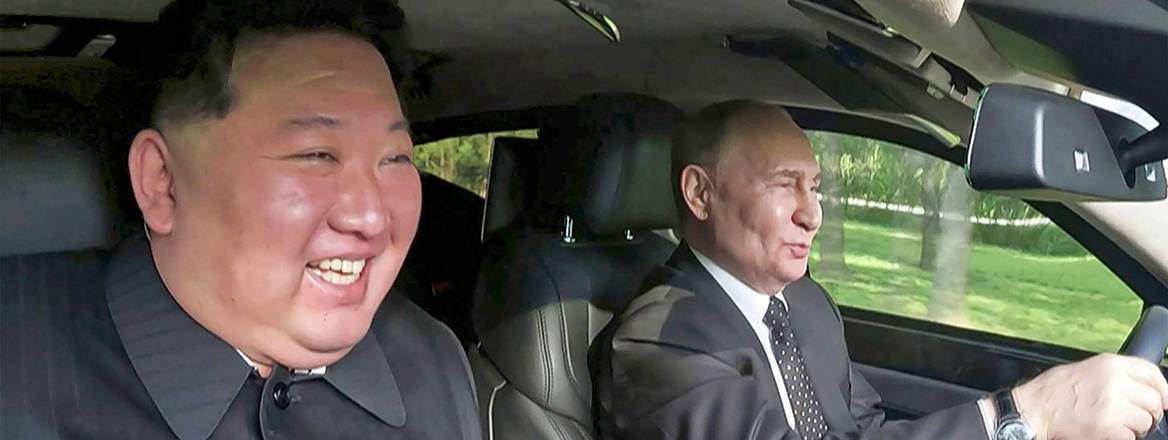Brothers in Arms: Assessing North Korea’s Contribution to Russia’s War in Ukraine
North Korea has supplied up to 5.8 million artillery rounds to Russia according to the Open Source Centre. This is potentially 40% of Russia’s ammunition, showing the extent to which North Korea’s illicit activity has extended the war.
Analysis conducted by the Open Source Centre (OSC), in conjunction with Reuters, and published on 15 April 2025 indicates that as many as 5.2 million rounds of 152 mm and 122 mm ammunition may have been supplied to Russia by North Korea since August 2023. This commentary will assess the extent of this contribution by estimating Russia’s total artillery expenditure since deliveries began in 2023 and examine how North Korean deliveries have surged to support Russia’s own offensives.
Shell Hunger
In August 2023 Ukraine’s long-awaited counter-offensive was under way, Russian units were prepared and waiting behind dense minefields, armed with anti-tank guided missiles (ATGMs), loitering munitions, and supported by large groupings of artillery and attack helicopters. This defensive posture proved too lethal for Ukraine’s brigades and the counteroffensive failed to secure any meaningful territorial gains, although it did bring Russia’s own offensive to a temporary halt. The Russian lines had held despite many deficiencies at that time. Amongst many challenges, the Russians lacked artillery ammunition after firing millions themselves, and Ukraine destroying thousands more through long-range strikes. This had constrained Russia’s artillery consumption with the result that ammunition and guns had to be concentrated in priority areas, leaving other areas of the frontline under-resourced.
Russia’s defence industry was expanding to address this need, but at that stage of the war, it could not do anything quickly to properly resource the units on the frontline. The answer to this dilemma soon became clear. President Putin had met with Kim Jong Un in July 2023, and satellite imagery analysed by RUSI from mid-August showed the start of regular shipments between Russia’s Dunai military facility on the coast of the Sea of Japan, and Rajin Port in North Korea. Simultaneously, the 719th Artillery Ammunition facility close to Tikhoretsk underwent a dramatic expansion with new berms added for large quantities of ammunition. This would become the end location for millions of rounds of North Korean artillery ammunition, which have helped keep Russia’s forces in the war. Those new berms were filling up by the time that Ukraine’s offensive came to an end in November 2023, and the war entered a new phase.
Overall, North Korean ammunition has kept Russia in the war, and arguably helped change its trajectory.
Both sides have since faced a shell hunger that has shaped the war significantly. Russia quickly emptied some of its pre-war stores, and eventually had to adapt the way it used artillery, leading to a greater focus on guided and loitering munitions. However, Russian units have come to depend upon deliveries of North Korean ammunition, which may constitute as much as 40% of the 14 million rounds fired since August 2023. It is clear that without North Korean support, Russia’s shell hunger would have been far worse, which means that North Korea’s illicit activities may have extended the war, or even prevented Ukraine from achieving greater success.
The Numbers
The OSC analysis used modelling and satellite imagery to estimate the number of 122 mm and 152 mm rounds that the identified Russian tankers could carry per journey. They were able to count and monitor 64 journeys by four vessels between Rajin and Russia’s Dunay and Vostochny ports since September 2023. It is estimated that these journeys delivered a minimum of 15,800 standard shipping containers. By modelling the size of Russian ammunition crates against the internal dimensions of ISO containers, the OSC arrived at a figure between 4.2 and 5.8 million munitions, including 122 mm and 152 mm artillery shells and 122 mm rockets.
With 4 October 2023 as a start date - to allow for the transit of North Korean ammunition to the front - and 18 April 2025 as an end date, the OSC analysis indicates that North Korea may have supplied enough ammunition for Russian units to fire 7,400 rounds per day. It is also possible to assess these figures against the totality of Russian ammunition expenditure since August 2023; table 1 below summarises publicly reported daily expenditure figures. Using these figures arranged against the available time period, it is possible to estimate the number of rounds that Russia has fired since North Korean deliveries started. This will obviously be an approximate figure, but it provides a metric against which to assess the relative impact of North Korean support to Russia.
This incomplete estimate indicates that North Korea has supplied between 29% and 40% (based on 4.2 and 5.8 million rounds respectively) of the total number of rounds that Russia has fired since deliveries began in 2023. These numbers do not allow for Ukraine’s strikes against Russia’s arsenals in September 2024, which destroyed large quantities of North Korean ammunition, leading to a temporary drop in rounds fired. For example, the strike on Tikhoretsk destroyed a train carrying an estimated 2,000 tons of ammunition, which could represent 24,000 152 mm rounds. There is no way of knowing how many rounds the Ukrainians managed to destroy, but it is unlikely that they have dramatically altered the overall picture given the scale of deliveries.
If North Korea had not supplied any ammunition at all, and the estimated total expenditure reduced by 5.8 million rounds, Russia’s daily average expenditure would fall to 13,493 per day from the current estimate of 22,729. This is still more than Ukraine for a lot of the period in question, but not dramatically so. Firing at this rate would likely have made many of Russia’s offensives in 2024 much more difficult and costly. It may also have limited the scope of offensives that Russia could undertake. In fact, the tempo of shipments indicates that North Korean shipments were timed to support major Russian offensive operations.
The OSC analysis indicates that Russian ships have averaged three deliveries per month since shipments started in September 2023. However, October, November and December saw 18 total shipments with seven in October alone coinciding with the beginning of the large-scale offensive to take Avdiivka, and the end of Ukraine’s own counter-offensive. A surge of another 13 deliveries between January and March 2024 appear to have supported Russia’s advance on Chasiv Yar, as well as the reopening of the Kharkiv front. Continued deliveries likely supported some stockpiling in preparation for the summer battles of Toretsk, Pokrovsk, and countering Ukraine’s advance into Kursk. Four shipments were observed in February 2025, as Russia prepared for its Spring offensive, recently announced by Ukraine’s general staff. This was the largest number of monthly trips observed by the OSC since the same month in 2024.
Impact Assessment
The impact of North Korea’s ammunition supply to Russia is hard to fully appreciate. At the strategic level, it is apparent that the renegade country has contributed significantly to Russia’s overall ammunition expenditure, likely helping Russia to keep fighting and sustaining its advances. The timings of deliveries also indicate that they have been key enablers of Russia’s offensives.
The impact at the tactical level has also led to important outcomes for the war. Ukrainian casualties more than doubled when the number of artillery rounds they could fire fell by half, a senior officer from Ukraine’s general staff told Reuters in July 2024. Manpower has since become a critical weak point for Ukraine as it struggles to hold ground and defend against Russia’s greater numbers. When Russia combined overwhelming firepower with higher ratios of troops, the Ukrainians have often faced defeat. This combination contributed to the fall of Avdiivka in February 2024; during the battle for Avdiivka, Russia had fired nine artillery rounds for every one the Ukrainians could fire back at times, and consistently outnumbered them in personnel. Avdiivka was quickly followed by the Russian capture of Krasnohorivka and Ocheretyne, and the expansion of Russian offensives through the Kharkiv front in May, further stretching Ukraine’s limited forces and ammunition. By October 2024 Russian forces had captured the city of Vuhledar after deploying some of the most intense artillery and glide bomb bombardments that Ukraine’s experienced 72nd Brigade had ever endured.
As 2024 came to a close, Russia had captured an estimated 4,168 square kilometres of territory, some of it from pushing Ukraine’s Kursk incursion back, but much of it Ukrainian land, captured in offensives that increasingly used North Korea’s ammunition. Supplies from Pyongyang have become so critical that some Russian units are only firing North Korean ammunition. Ukraine’s manpower struggles were compounded by Russia��’s ability to fire more and more rounds to sustain offensives in the face of mounting casualties, with the net result being an overall worsening of Ukraine’s position by the end of 2024.
Looking ahead, the available evidence suggests that both Russian and North Korean factories are working to churn out more rounds than ever, with new production lines established and their legacy factories operating at maximum capacity. There will likely be some emphasis on replenishing stockpiles, but it stands to reason that many of the rounds the two states produce will be used in Ukraine.
Overall, North Korean ammunition has kept Russia in the war, and arguably helped change its trajectory. If the supply increases and can be sustained for months on end, Ukrainian casualties will climb and Russia’s will fall. More territory will be taken, and Ukraine’s position will become ever more tenuous.
© RUSI, 2025.
The views expressed in this Commentary are the author's, and do not represent those of RUSI or any other institution.
For terms of use, see Website Terms and Conditions of Use.
Have an idea for a Commentary you'd like to write for us? Send a short pitch to commentaries@rusi.org and we'll get back to you if it fits into our research interests. View full guidelines for contributors.
WRITTEN BY
Sam Cranny-Evans
RUSI Associate Fellow, Military Sciences
- Jim McLeanMedia Relations Manager+44 (0)7917 373 069JimMc@rusi.org



